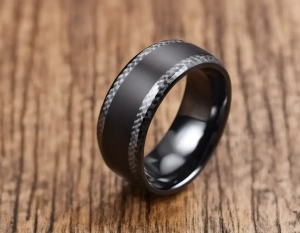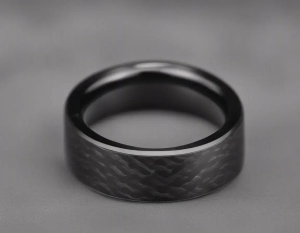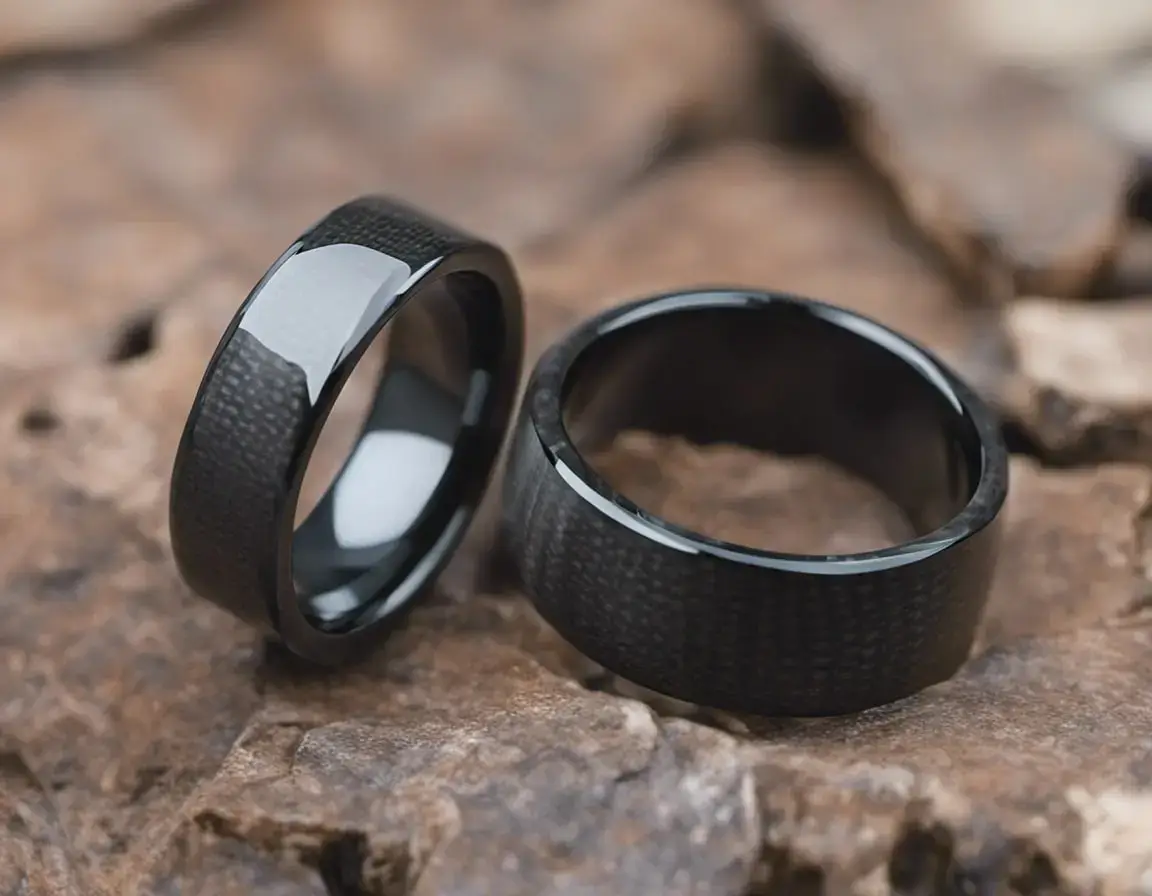Inlay rings are made by meticulously fusing several materials into the ring’s band to produce magnificent patterns. The procedure entails choosing materials like carbon fiber, metals, wood, or even precious stones. These components are formed, cut, and placed into the ring’s metal band’s grooves or depressions. The end result is a stunning and detailed pattern where the ring’s general design is enhanced and complemented by the inlay materials. Inlay rings are prized works of wearable art because they offer a distinctive fusion of skill, imagination, and customization.
What Are Inlay Rings ?
When different materials are intricately placed into the band of a ring, it is called an inlay ring. These materials may be made of wood, ceramics, metals, gemstones, and more. In order to fit the materials into the ring’s design and create patterns and motifs, the materials must be meticulously cut and shaped during the inlay process. Inlay rings are renowned for their distinctive and eye-catching designs, frequently incorporating symbolic meaning from the wearer’s life or work of art. They are prized as accessories that let wearers show off their distinct tastes and styles.
The Lava Inlay Ring That’s Both Striking and Subtle
Lava ring is a mesmerizing masterpiece crafted with fragments of red black opals, forming a stunning lava-inspired pattern. This unique and expertly handmade ring is undoubtedly one of the most beautiful and best inlay rings you can buy.
Each Lava ring is a one-of-a-kind work of art, ensuring that you or your loved one will own a truly unique piece. The skillful craftsmanship and durable materials used guarantee that this ring will remain a cherished accessory for years to come.
The versatility of the Lava ring knows no bounds, making it the perfect choice for any occasion. Whether you’re attending a formal event or simply enhancing your everyday look, this ring adds a touch of elegance and edginess that is sure to turn heads.
Treat yourself to the exquisite beauty of the Lava ring or surprise someone special with a gift that will leave a lasting impression. Embrace the beauty of nature’s fiery forces with this mesmerizing lava-inspired design, capturing the essence of power and beauty in every intricate detail.
With its unique design and enduring appeal, the Lava inlay ring is an investment in timeless elegance and exceptional craftsmanship. Don’t miss the opportunity to own one of the most beautiful and best inlay rings available – embrace the allure of the Lava ring today.

History of Inlay Rings
The history of inlay rings is lengthy and fascinating, spanning several civilizations and cultures. The fact that rings have been inlaid with materials for thousands of years demonstrates the artistic and cultural value of these adornments. An summary of inlay rings’ past can be found here:
One of the first instances of inlay rings was discovered in ancient Egypt. The Egyptians were expert craftsmen who used complex methods to make beautiful jewelry. This time period’s inlay rings frequently used priceless metals like gold or silver and were adorned with vibrant stones like lapis lazuli, turquoise, and carnelian. These components were meticulously incorporated into the rings to produce eye-catching patterns.
Ancient Rome: Inlay rings gained popularity during the Roman Empire’s existence. The love of jewelry that the Romans had was well known, and they frequently decked themselves with expensive items. The materials used in inlay rings during this time period ranged from jewels to glass to enamel to even tiny fragments of carved ivory or bone. Intricate patterns and designs were created by setting these materials into the metal band of the ring.
Europe in the Middle Ages and the Renaissance: Inlay rings developed further during these historical eras. These rings frequently featured enamelwork, which was accomplished by fusing glass powder onto the metal surface and then burning it to produce vivid and long-lasting designs. At this period, inlay rings included delicate metalwork, like as filigree and carved features.
Asian Cultures: A number of Asian cultures have made considerable use of inlay rings. Jade, for instance, was a preferred material for inlay rings in ancient China. Jade was highly prized for its aesthetic appeal and symbolic meaning, and it was frequently used in magnificent patterns in conjunction with other materials like gold, silver, or other jewels. In Japan, rings with layered designs and textures were made using ancient inlay techniques like mokume-gane.
Contemporary Inlay Rings: Contemporary jewelers use a variety of materials and techniques to continue the art of inlaying in the modern era. These days, inlay rings can include a variety of materials, including precious metals, diamonds, enamel, wood, ceramics, and even contemporary options like carbon fiber. The development of inlay techniques has also been aided by machinery and contemporary technology, enabling the creation of elaborate and exact designs.
Inlay rings are aesthetically pleasing and have cultural importance; they frequently stand for prestige, symbolism, or individuality. Inlay rings continue to be prized as lovely and significant items of jewelry across various cultures and eras, whether they are influenced by ancient traditions or modern designs.
Techniques and Processes inlay rings
Inlay rings are made using a variety of methods and procedures that call for dexterity, accuracy, and attention to detail. Here are a few methods and procedures that are frequently used to make inlay rings:
1. Material Selection: Choosing the materials that will be utilized is the first stage in making an inlay ring. Various materials, including metals, wood, enamel, ceramics, and alternative materials like carbon fiber, can be used for this. The materials have to compliment one another in terms of both durability and appearance.
2. Design and Layout: After selecting the materials, the inlay pattern’s design and layout must be planned. This entails figuring out where to put each element inside the ring and how to arrange it. It’s crucial to take into account elements like color, texture, and the overall visual harmony of the design.
3. Cutting and Shaping: The next step is to cut and shape the selected materials to meet the intended design. Metals or other materials might need to be cut into precise strips or pieces, whereas gemstones can be shaped into specified shapes like round, square, or oval. Careful cutting methods and the usage of specialized instruments are required for this process.
4. Channeling or Recessing: A channel or recess is made in the metal band to attach the inlay materials in the ring. To accomplish this, carefully drill or carve a groove into the metal, making sure the groove is the right size and depth to hold the inlay materials.
5. Fitting the Inlay: The materials for the inlay are next put into the ring’s channels or recesses. To guarantee a tight fit, this needs to be placed precisely and fitted. The inlay materials can be further fixed in place by applying adhesives or epoxy.
6. Finishing and Polishing: Following the installation of the inlay materials, the ring goes through a finishing and polishing procedure. To attain a high-quality finish, the metal surfaces must be meticulously polished and buffed. To achieve the appropriate brightness and luster, a variety of procedures can be used, including buffing, polishing, and sanding.
7. Finishing touches: Any additional information or embellishments, like as engraving or decorative accents, may be applied after the finishing process to improve the ring’s overall look. This process enables modification and customization based on the preferences of the jeweler or wearer.
Skilled artisans and jewelers use specialized tools and procedures particular to the materials being used throughout these operations. The inlay ring is a one-of-a-kind and gorgeous piece of jewelry because of the craftsmanship, attention to detail, and artistic vision that went into creating it.

Care and Maintenance inlay rings
Inlay rings must be maintained and cared for properly to maintain their beauty and longevity. Following are some suggestions:
1. Keep Your Inlay Ring Away From Harsh Chemicals: Your inlay ring should be kept away from harsh chemicals including bleach, chlorine, and abrasive cleaning agents. These compounds have the potential to harm both the inlay materials and the metal band. Before using cleaning products or indulging in activities that involve chemicals, take off your ring.
2. Gentle Cleaning: To get rid of debris, oils, and other leftovers that may build up over time, gently clean your inlay ring on a regular basis. To clean your jewelry, use a soft, non-abrasive cloth or a solution made especially for the metal and inlay materials used in your ring. To keep the surface’s gloss and luster, gently wipe it down, especially the inlay.
3. Impact Resistance: Inlay rings can be delicate, particularly if they contain diamonds or other brittle materials. Do not subject your ring to impact, harsh handling, or other actions that could scratch or harm it. Before engaging in intense activities, sports, or any other scenario where it might be subjected to excessive force, take off your ring.
4. Storage: Keep your inlay ring out of direct sunlight and clean, dry areas while not in use. Keep it away from other jewelry that could scratch or harm the surface when keeping it. To shield the ring from dirt, moisture, and potential damage, think about using a jewelry box or a soft pouch.
5. Professional Upkeep: Have your inlay ring periodically examined and cleaned by a qualified jeweler. They are able to look for any loose stones, possible damage, or wear and tear. Professional cleaning can make the metal more brilliant and guarantee that the inlay materials are safe.
6. Prevent Extreme Conditions: Guard your inlay ring from harsh weather and conditions. Avoid subjecting it to abrupt temperature variations because they can harm the inlay materials as well as the metal. Additionally, it’s crucial to preserve the ring in a controlled environment because some materials, like wood or enamel, may be more sensitive to moisture or humidity.
7. Inspect Your Inlay Ring for Loose Inlay: Check your inlay ring frequently for any indications of loose inlay materials. Listen for any rattling or movement as you lightly tap the ring on your hand. If you find any loose inlays, have them fixed right away by a qualified jeweler to prevent further destruction or material loss.
You can make sure that your inlay ring stays in outstanding shape and keeps its beauty for many years by adhering to these maintenance and care procedures. Keep in mind that for the greatest care, it is best to adhere to any special care instructions or suggestions given by the jeweler or producer of your inlay ring.





Leave A Comment